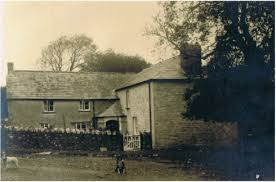.

John was born on the 5th of June 1819 the eldest of seven children to Thomas and Tabitha Knill (nee Grylls) Adams at Lidcot farm, Laneast. His father was a tenant farmer, Lidcot (below) being part of the Tregeare estate. The family were devout Wesleyans. Of John’s brothers,  Thomas became a missionary, George a farmer, and William a professor of natural philosophy and astronomy at Kings College London.
Thomas became a missionary, George a farmer, and William a professor of natural philosophy and astronomy at Kings College London.
Although the family were poor it was through his mother, Tabitha that John received his keen interest in astronomy. Tabitha had received a rudimentary education from her uncle John Couch who held a small library of which she inherited. John attended Laneast school where he learnt some Greek and algebra. At the age of twelve, he went to his mother’s cousin’s, the Rev. John Couch Grylls private school at Devonport, Plymouth. Although he learnt the classics he largely self-taught himself mathematics, studying in the library of the Devonport Mechanics Institute. In 1835 from Landulph he experienced the sight of Halley’s comet which drove him on the following year to make his own astronomical calculations, predictions and observations, offering private tutoring to subsidies his life. Later on that year his mother inherited a small estate at Badharlick and witnessing Johns predisposition towards mathematics, his parents along with the encouragement of Mr J. K. Lethbridge funded his attendance at the University of Cambridge. In 1839 he entered as a sizar (a student who receives some form of assistance such as meals, lower fees or lodging during his or her period of study, in some cases in return for doing a defined job) at St. John’s College, graduating B.A. In 1843 as the senior wrangler (is the top mathematics undergraduate at Cambridge University in England, a position once regarded as “the greatest intellectual achievement attainable in Britain) and first Smith’s prizeman of his year. The Smith’s Prize was the name of each of two prizes awarded annually to two research students in Theoretical Physics, mathematics and applied mathematics at the University of Cambridge.
In July of 1841, he noted his intention to work on the problem that Alexis Bouvard had discovered in the orbit of Uranus. Bouvard found that in predicting the planets future positions based on Newton’s laws of motion and gravity there were substantial deviations which led him to believe that there was some perturbing body affecting the figures. John felt that using just the observed data on Uranus and utilising Newton’s law of gravitation he could deduce the mass, position and orbit of the perturbing body. After his final examinations in 1943, John was elected a fellow of his college and returned home to Cornwall for this vacation. Here he calculated the first of six iterations.
On his return to Cambridge, he continued to work on the problem whilst tutoring undergraduates as a means to live and also to send money home so that his brothers would receive a good education. By mid-September 1845 John’s research had reached a conclusion but he failed after two attempts to meet with George Airy, the Astronomer Royal it is reputed that he left a manuscript of his findings but without any detailed calculations. Airy responded with a letter to John asking for some clarification as to his findings. Unfortunately, John failed to reply. Whether this was down to nervousness or basic disorganisation no one knows.
Meanwhile, on the 10th of November 1845, the Frenchman Urbain Le Verrier presented to the Académie des sciences in Paris his research on Uranus. His work showed that the pre-existing theory failed to account for its motion. It struck George Airy, after reading Le Verrier’s memoir of the coincidence and he initiated a race for English primacy in the discovery of the planet. From the 29th of July 1846 an extensive and laboured search was begun. However it was only after the discovery of Neptune had been announced in Paris on the 23rd of September 1846 did it become apparent that Neptune had in fact been observed on the 8th and 12th of August 1846 by the director of the Cambridge Observatory James Challis, but because he lacked an up to date star map it was not recognised as a planet.
With the facts becoming public knowledge, there was wide recognition that the two astronomers had independently solved the problem of Uranus and both were ascribed equal importance in Neptune’s discovery. The French did make assertions that the ‘Brits had stolen Neptune’ and that in Britain John Adams was ascribed more credit than he was due, but John did publicly acknowledge Le Verrier’s priority and credit in the paper that he gave ‘On the Perturbations of Uranus’ to the Royal Astronomical Society in November 1846. John acknowledged his own failings in convincing Challis and Airy of his findings and held no bitterness towards them.
John was Lowndean Professor at the University of Cambridge for thirty-three years from 1859 to his death. He won the Gold Medal of the Royal Astronomical Society in 1866. In 1884, he attended the International Meridian Conference as a delegate for Britain. A crater on the Moon is jointly named after him, Walter Sydney Adams and Charles Hitchcock Adams. Neptune’s outermost known ring and the asteroid 1996 Adams are also named after him. The Adams Prize, presented by the University of Cambridge, commemorates his prediction of the position of Neptune. His personal library is now in the care of Cambridge University Library.
John passed away after a long illness at Cambridge on the 21st of January 1892. He was interred at the Ascension Parish Burial Ground
Cambridge.
Visits: 96
